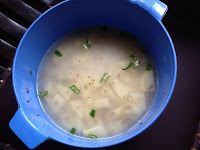Happy Gokulashtami ! Hope you are enjoying your Gokulashtami celebrations your own way. Here in Mumbai amidst din I am here to quickly post a naivedya I just made for Lord Krishna. Shh..Shh.. Also to inaugurate my new stainless steel cookware.
Last night was Krishna Janma or birth of Lord Krishna so I made Steamed Rava Ladu for naivedya. And today is Gopal Kala or Dahi Handi. I don't need to reiterate how this festival is celebrated here in Mumbai. This city has its two festivals when the citizens come out on the street and for this one shouting out Govinda Aala Re, Aala Jara Matki Sambhal Brij Bala! Here Bala means young woman, how endearing! Hope the days of that pure love and clean fun returns to this city. That's my prayer today.
Now here is the quick recipe of my second naivedya. This is a Rajasthani recipe which transforms the pantry staple atta into a delicious halwa with dollops of ghee. So be generous!
Ingredients
1/2 cup wheat flour / Atta
1 tablespoon + 1 teaspoon Ghee
1/2 cup sugar
1 pinch salt
Slivered pistachios for garnish
Washed my brand new 18/10 SS Kadhai (note that). Kanha it should taste better than my previous Aluminium Kadhai and also no farting now and blaming it on Al OK! :D
Ok what are you laughing at? heat that Kadhai. Add one tablespoon ghee and when molten add the wheat flour to it. Roast it till dark brown and aromatic. Don't roast it till caramelisation as the color intensifies further as we use sugar syrup to make the halwa.
While you are roasting the atta in a saucepan boil together 1/2 cup sugar and 1 cup water till sugar dissolves. This is your sugar syrup. Add a pinch of salt to bring out the sweetness of sugar.
Once the atta is nicely fragrant and golden add slowly sugar syrup to it. Keep stirring till the atta absorbs all the liquid and is plumped up. At this point at about 5 mins the halwa is cooked to perfection and will start forming a mass at the centre. Now add one teaspoon ghee to give it a glaze. Keep stirring.
Finally garnish with slivered pistachios.
Tastes best warm.
.




























